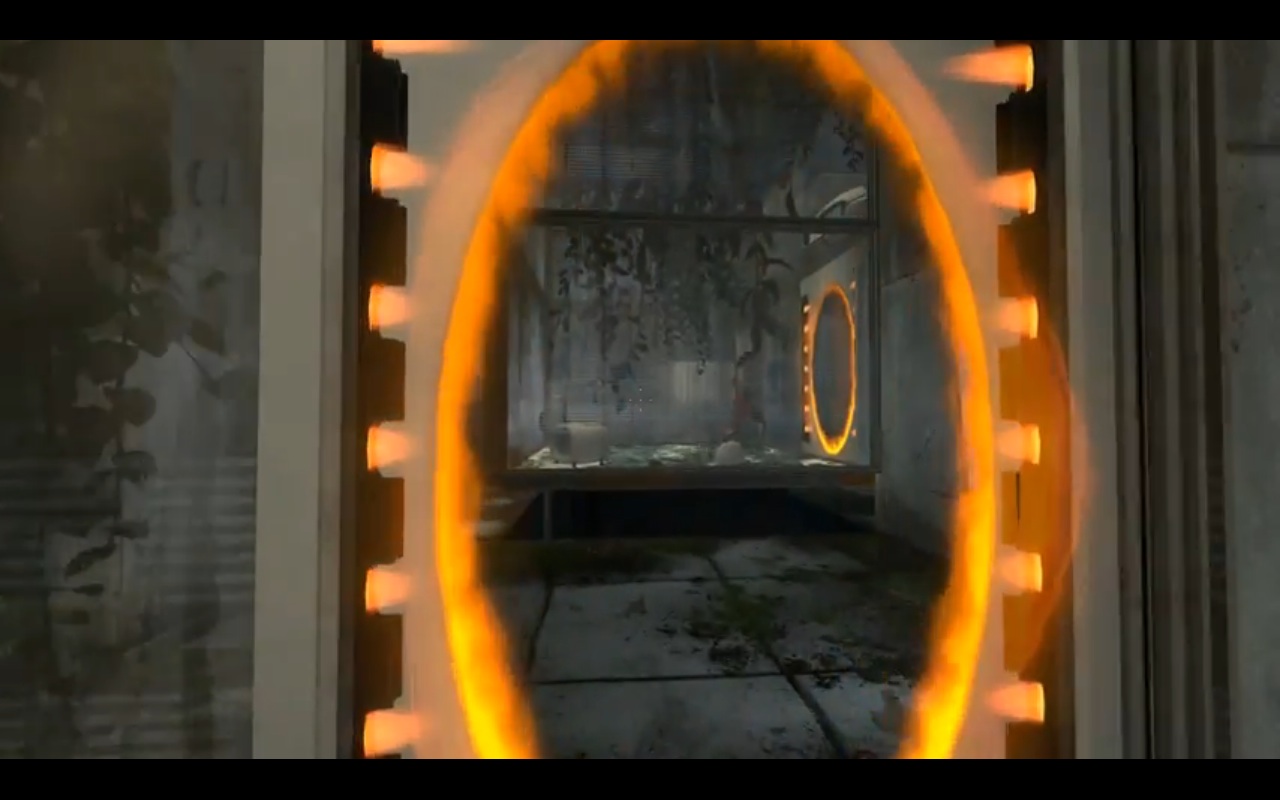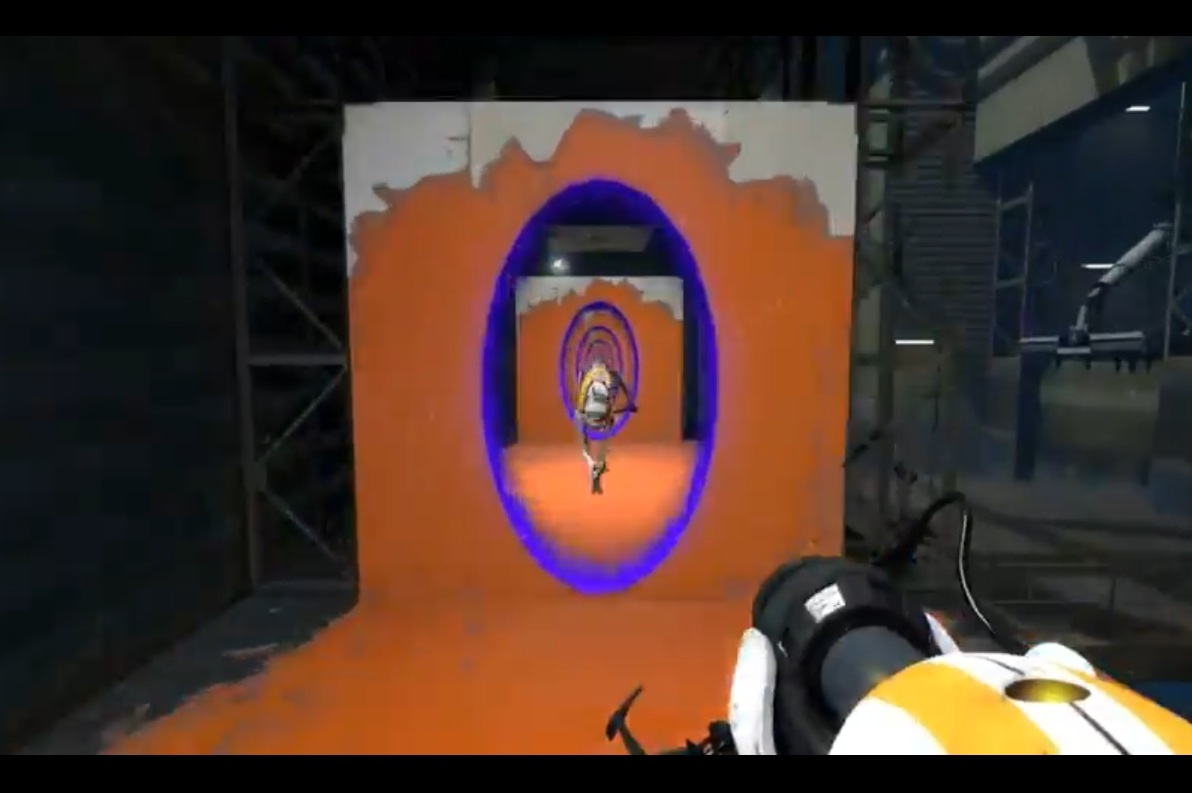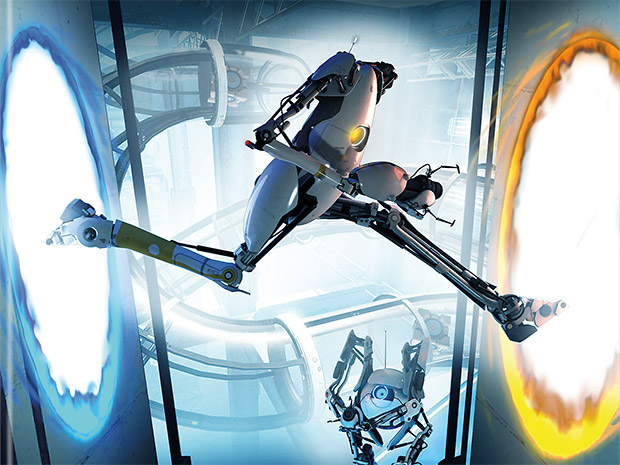Portal 2 and Point of View
![]() In the depths of Aperture, I sometimes glimpse another. I’m about my business – puzzling through space, feeling smart, doing science – and there she is. Shooting ahead, turning a corner. It’s just me in here, save the voices, and yet it’s suddenly creepy to think I’m not alone.
In the depths of Aperture, I sometimes glimpse another. I’m about my business – puzzling through space, feeling smart, doing science – and there she is. Shooting ahead, turning a corner. It’s just me in here, save the voices, and yet it’s suddenly creepy to think I’m not alone.
I’m seeing myself, of course, but it’s not some trick with mirrors, a reflection of light. It’s what I see with portals. Portal 2 keeps asking me to think with portals, but I like to think about them too. Each time I shoot a second portal, a connection is made, a gap closed, and I feel a little synaptic spark. There’s something about this mechanic, like Mario’s jump, that is inherently compelling (a portal, too, is a kind of jump – a local, mobile warp zone). Each time I connect portals, I wonder: what will I see, what will be revealed?
(Please finish Portal 2 before reading further.)
A portal is a door. Not to some fantastic world. It’s local transport, yet so unlike all those rickety pneumatic tubes veining Aperture. It’s not even like the less anachronistic elevators. Though, admittedly, an elevator is kind of like a slow portal, with a small waiting room inside.
Final moonshot notwithstanding, these portals aren’t meant to take us far. No wormholes or slipspace drives shifting us to the other side of the universe. They are designed to take us back into our own room. The establishing portal shot of both games, Chell in her cell, confirms this. Portals bend the architecture of the world so that we see it from a new point of view.
Thus, a portal is also a window. Windows mean to point out there, somewhere not here. But portal windows, like portal doors, usually point back in. They allow your eyes to be in two places at once, to occupy, literally, multiple points of view.
There is great pleasure in this. Not just moving through portals and all the attendant cleverness, but in the very seeing itself. I look to my portal, straight ahead, and see also from behind or above. I set my portals just so and get a good look at myself, my Chell, bootstraps and all. I move this way but she goes the other; I forget, so trained on mirrors, to recross my brain signals; I remember, suddenly, the frustration of first trying to control my direction on the live feed of a camcorder.
To think with portals is to play with point of view. First-person games are so much about looking anyway – the player encounters views and collates them into mental maps of three-dimensional space. Most first-person shooters go further and equate aiming with viewing. To aim is to constantly recenter the screen, to align the proper view. Zooming is the action of a camera, or a sniper rifle. The standard first-person view becomes, thus, a look that kills.
Of course, shooting in Portal 2 feels rather more innocuous. My two bullets, orange and blue, together project a point of view, a ghostly second set of eyes from which I can launch some new disaster. It provides a kind of out-of-body experience (doubly so, if I remember that I was already having one by playing a videogame). But then, first-person games aren’t much about the body anyway. I only need reflect on how limited jumping remains in first-person (versus side-scrollers and all manner of third-person) to sense how disembodied that gaze can be. Chell herself is not actually good at jumping; she’s good at falling, and landing.
The player’s true power is control over the viewing window, over what is seen. And with your portal gun in hand, over the creation of new points of view. Valve pioneered free looking during scripted events years ago, but this extends that freedom in radical new directions. What was once an uncut, singular view has now multiplied without taking control from the player or altering the basic first-person perspective. By recreating a static, mobile point of view within the player’s standard window, Valve signals that it is ready to take up deeper into the first-person videogame experience, seamlessly.
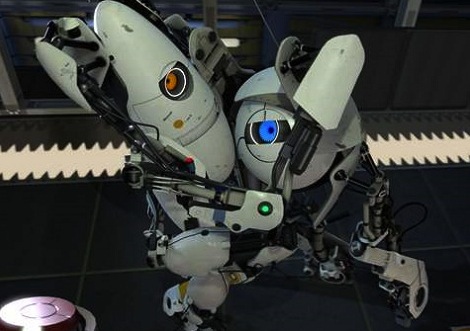 This becomes clearer to me while playing splitscreen co-op. My eyes constantly drift over to my brother’s half, not just to coordinate plans but to spy my squatty Blue. This offers me the chance to see myself from another point of view – his first-person is effectively my own limited third-person. (When he looks my way, that is; sometimes I have to remind him: Look at me!) We’ve played every Halo together on co-op, but his view has never been so weirdly compelling.
This becomes clearer to me while playing splitscreen co-op. My eyes constantly drift over to my brother’s half, not just to coordinate plans but to spy my squatty Blue. This offers me the chance to see myself from another point of view – his first-person is effectively my own limited third-person. (When he looks my way, that is; sometimes I have to remind him: Look at me!) We’ve played every Halo together on co-op, but his view has never been so weirdly compelling.
Finally, I can see what it looks like when I launch one of our Rube Goldberg solutions to a puzzle. Instead of just catapulting through the air and trying to feel the breezeless momentum, I actually see my robot body’s stiff arc. I hadn’t realized before how many of the wilder spatial contortions in the single-player game take place almost exclusively in my mind. I learn to read the rooms, sort the possibilities, order them correctly, and then take my place in the contraption – the final piece. But only to catch a fleeting, incomplete glimpse of how the whole process appears.
It is not simply more satisfying to see myself in action from outside my own viewpoint in co-op; it is more compelling to compare the points of view, especially with our portals in play. The endless run of two facing portals becomes just one infinitely long tunnel in first-person; it has a hall-of-mirrors feel, sure, but it is all of a piece. From my brother’s more distant point of view, though, it looks like a mistake, a glitch in the matrix. There I am, caught in some continual cartoon loop, and it looks, basically, insane. From my point of view, space is continuous, whole, one. From his, standing still, there is just some lunatic scurrying in and out of holes.
To put it another way: compared with my point of view, his view of me feels less…continuous. To use a portal in first-person is to bend space in one single motion; its brand of teleportation offers no rupture (the elevator door never closes). But to watch another, or yourself from another’s view, is to see a more stable architecture and thus a more pronounced portal movement, a more impressive magician’s trick. These views are not accidental. Portal 2’s co-op game often demands that you watch your partner in order to coordinate buttons and solve its ‘asymmetric trust puzzles’. If you don’t already know to compare points of view, the chambers will train you, like a good test subject.
At the end of every course, it becomes clear just how hard it can be to measure discontinuities in the first-person. Blue and Orange are disassembled, but you wouldn’t know it without your hapless partner’s mirrored fate. My brother’s dismantling wrenches my eyes to his screen, again, to see what deconstruction looks like in the first-person. And lo, there I am experiencing the same thing. Numb as my virtual body is, I can’t process my own temporary death until they take, at last, my single blue eye.
I am reminded of how necessary a death animation can be to fully register this breach. A sideways fall to the floor to ‘simulate’ a first-person death gaze just doesn’t feel as final. It’s as if I must see the body to believe the death, even if that body is my own. I remember how death in the original Halo exorcised my spirit so that I might experience the collapse of my ragdoll Chief from outside his body. Halo: Reach even makes this manifest in its endgame through the removal of Noble Six’s helmet (the player’s screen, a shattered view) to witness his last stand against the Covenant. Without the confirmation of this alternate view, and the blasted helmet artifact, we would naturally wonder: is this actually the end? Am I really the “past president of the being alive club”?
The main story of Portal 2 unfolds as a series of competing points of view. Cave Johnson’s supermanic, science-as-pissing-contest ethos vs. GlaDOS’s manipulative, wounded maternal sarcasm vs. Wheatley’s single-minded, artificially idiotic inferiority/God complex. Both Cave Johnson and Wheatley’s oblivious perspectives read as specifically male – Cave the mid-century American patriarch, all can-do delusion; Wheatley the more contemporary domesticated dummy, seething resentment and ready to claim any throne. Both must be overcome in the end by our trusty Samus-Mother Brain team-up if Aperture is not to go ALL to hell.
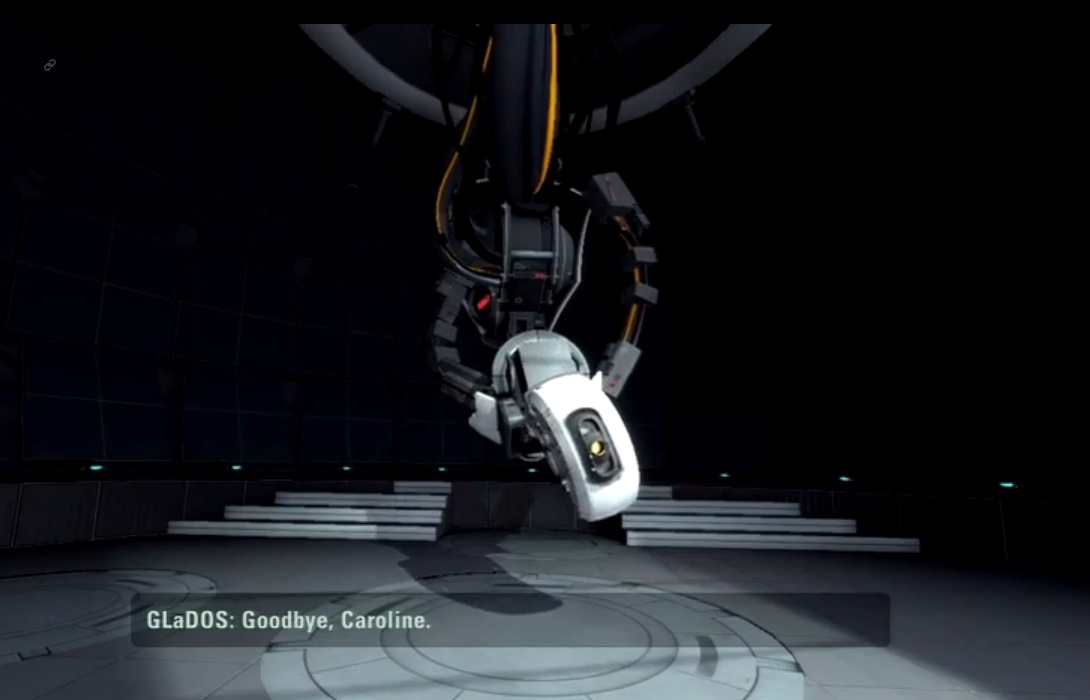 Portal 2 is certainly well-written enough to sustain a powerful eco-feminist interpretation of its narrative. The creation, vengeance, and partial redemption of GlaDOS elaborate the consequences of treating women and Science so recklessly (say “goodbye”, Caroline…“Goodbye, Caroline”). But this doesn’t require a videogame to be argued. Instead, we must ask how the gameplay mechanics, the verbs offered the player and their consequences in the gameworld, determine the meaning we experience. GlaDOS may find her own voice, temporarily, but silent Chell can only speak with a portal gun. So what does this gun say?
Portal 2 is certainly well-written enough to sustain a powerful eco-feminist interpretation of its narrative. The creation, vengeance, and partial redemption of GlaDOS elaborate the consequences of treating women and Science so recklessly (say “goodbye”, Caroline…“Goodbye, Caroline”). But this doesn’t require a videogame to be argued. Instead, we must ask how the gameplay mechanics, the verbs offered the player and their consequences in the gameworld, determine the meaning we experience. GlaDOS may find her own voice, temporarily, but silent Chell can only speak with a portal gun. So what does this gun say?
It says: move, for one. As a door, a portal urges trespass, albeit playfully. Portals play with space, but this transgression can only be fully realized by passing through. Why does this matter? Because Chell’s tenacious, bootstrapped mobility is one of her defining features. I remember how oddly compelling I found GlaDOS’s design when I first encountered her hanging from the ceiling, like some torture victim primed for interrogation. She controlled the space around her, and moving through the facility almost felt like moving through her. But she was actually strung up and rooted in place. She needed human test subjects (and later Blue and Orange) to move through space as agents, actors, persons.
Compare this to the initially humble Wheatley, who is mobile though on tracks. He yearns to go off the rail, but he’s a child to be carried when he actually succeeds. His downfall at the core transfer can be understood as not just the effects of power upon the weak-minded, but of the loss of mobility and all its inherent vulnerability. Wheatley becomes massive, meaning everywhere. With his sensors arrayed and screens cued to spread his vision over all of Aperture, he experiences that intoxicating, delusional feeling of power that comes with stillness. It comes to me more commonly at night, in bed, alone in the darkness, or while stationed before a video screen. The illusion of omnipresence, everywhere and nowhere. God in his heaven, the villain in his lair.
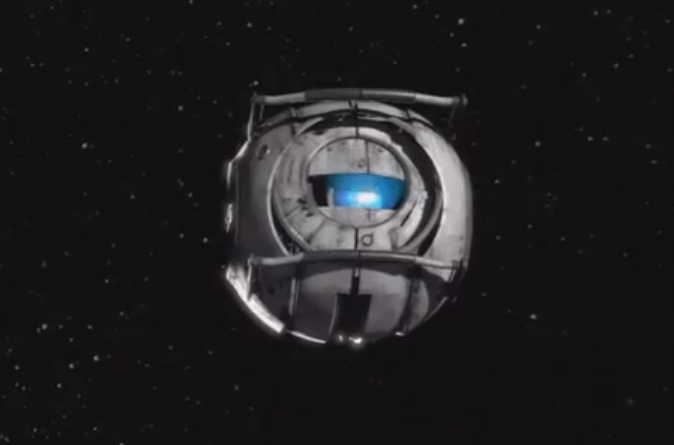 But to move through space is humbling. One must submit to gravity, walls, the mire of dimensions. To the basic powerlessness and singularity of being a person in the world. When Wheatley is returned to space, the black and cold one, his tyrannical impulses wither. He is truly sorry. Likewise, GlaDOS approaches personhood, with all its pitfalls, not only by being reminded of Caroline but by becoming a potato, remnant of a child’s science project, easily tossed or eaten. Once Chell attaches her to the portal gun, the actual journey through space offers her a whole new point of view.
But to move through space is humbling. One must submit to gravity, walls, the mire of dimensions. To the basic powerlessness and singularity of being a person in the world. When Wheatley is returned to space, the black and cold one, his tyrannical impulses wither. He is truly sorry. Likewise, GlaDOS approaches personhood, with all its pitfalls, not only by being reminded of Caroline but by becoming a potato, remnant of a child’s science project, easily tossed or eaten. Once Chell attaches her to the portal gun, the actual journey through space offers her a whole new point of view.
The portal gun is, itself, significantly mobile. So many teleportation devices use the logic of beaming – space stays the same and the object is zapped across it. The portal gun, though, bends space itself while the transported object retains its structural integrity (not just my Chell, but the varied gels, tractor beams, and hard light bridges). The shooter is thus both the locus of a kickass power over space as well as what limits it in space. The portals placed, and misplaced, are the means of both player progress and player death. Their power is projected only as far as the eye can see.
And so, even before it says ‘move’, Chell’s gun says: look. Or in firearm parlance: aim. The portal window must first be placed to be used. On a surface, not midair. Why repeat the obvious? Because alternate teleportation devices (the Enterprise beam, the Battlestar calculation, the Cronenberg pod) are not dependent on the first-person, on aiming with eyes. Eyes need surfaces to stop the light and define the visible. They don’t operate in some wireframe 3D space. Portals are bound to the first-person by their very design.
If this seems to over-read Portal 2 for vision, consider: Wheatley, like every core, is an eye; the potato is a vegetable with an eye (even GlaDOS’s only recognizable feature, post-op, is her glowing eye); and of course there’s the optical focus in the very name of APERTURE Science Laboratories.
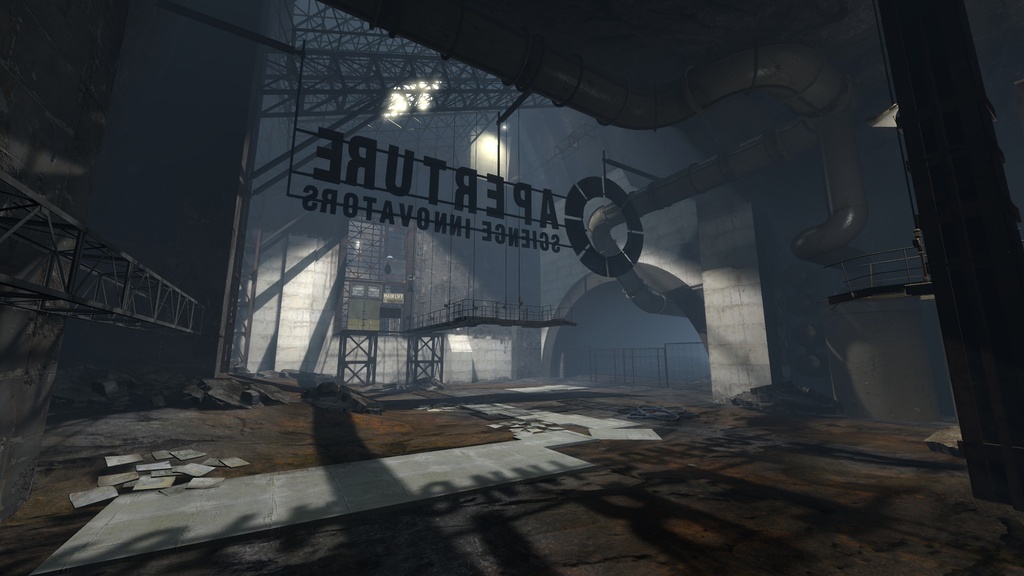 Videogames have under-examined powers to literalize. Cave Johnson’s superman vision of science (faster than a speeding bullet, able to leap tall buildings in a single bound) finds literal expression in propulsion and repulsion gels. Wheatley’s stunted, simple-minded perspective becomes the very architecture you must inhabit and subvert. How do you defeat him in the end? One way of putting it might be: by attaching more robot eyeballs. He can’t handle multiple visions, literally; they confuse and overwhelm his singular stupidity (and note the masculine shades of the corrupt cores: a juvenile obsessed with SPACE, an old-timey Cave Johnson adventurer, an ignorant, egotistical spewer of ‘facts’). Wheatley is a villain, in part, because he’s incapable of incorporating and adjudicating multiple points of view, despite all his power.
Videogames have under-examined powers to literalize. Cave Johnson’s superman vision of science (faster than a speeding bullet, able to leap tall buildings in a single bound) finds literal expression in propulsion and repulsion gels. Wheatley’s stunted, simple-minded perspective becomes the very architecture you must inhabit and subvert. How do you defeat him in the end? One way of putting it might be: by attaching more robot eyeballs. He can’t handle multiple visions, literally; they confuse and overwhelm his singular stupidity (and note the masculine shades of the corrupt cores: a juvenile obsessed with SPACE, an old-timey Cave Johnson adventurer, an ignorant, egotistical spewer of ‘facts’). Wheatley is a villain, in part, because he’s incapable of incorporating and adjudicating multiple points of view, despite all his power.
Which is not to say that containing multitudes ensures broad-mindedness and compassion. In the first Portal, GlaDOS proves remarkably well-integrated, a hyper-competent administrator. Her psychological programming provides enough flexibility to deal with all sorts of test subjects, and yet she is quick to reduce Chell to the traits in her file: unlikeable, adopted. The credit sequence of Portal 2’s co-op campaign expands the full humor, and horror, of this by reducing all the new test subjects to single words and phrases: “blabbermouth”, “always sulking”, “moves lips while reading”, “lacks empathy”.
And so, GlaDOS must be similarly reduced, limited, uncomplicated via core removal to be defeated. This very idea is expanded in Portal 2 when Wheatley is revealed to have been designed as a handicap for GlaDOS. This adds a bit of pathos, retroactively, to what Chell was forced to do to GlaDOS the first time around. As it turns out, people have been reducing and limiting GlaDOS (and Caroline as sidelined assistant) her whole life.
So, how many points of view are best? If one is too limited and a googolplex is too intoxicating and inhuman, then what is the goldilocks compromise? Do certain games, like Portal 2, allow us to explore some space in-between? By thinking with portals and playing with point of view, I begin to reconsider the first-person perspective. It feels limiting at first, but portals push me past, or through, this initial reaction. Their role in both the narrative and the gameplay itself – as windows and doors – reminds me of how powerfully first-person can serve as a point of view that contains other points of view.
Let’s go one, no two, further. Portals are also holes. When I simply look at a portal, I see a tear in a solid surface. I relish the potential discovery of some hidden space, the backstage of the world. I think of the primal pull of the secret passage, of the underground, and I remember how the childhood discovery of holes in the earth inspired Shigeru Miyamoto to create The Legend of Zelda.
Portal 2’s environments are structured around such pleasures. The original reveal of rusty plumbing behind the antiseptic walls of Aperture in the first Portal gives way to full-blown revelation in the sequel. The opening deconstruction of Chell’s ‘room’. The broken-down test chambers and self-replacing walls that allow glimpses of the larger facility. The Cave Johnson back-story made concrete in the literal foundations of Aperture. Wheatley’s desperate room mash-ups that expose the seams of a cubic city, a world gone rigorously mad. Even the final ejection into an open field on the surface. Portal 2 constantly pulls back the curtain on all of Aperture’s illusions to reveal a hidden reality. I think: this must be what SCIENCE feels like.
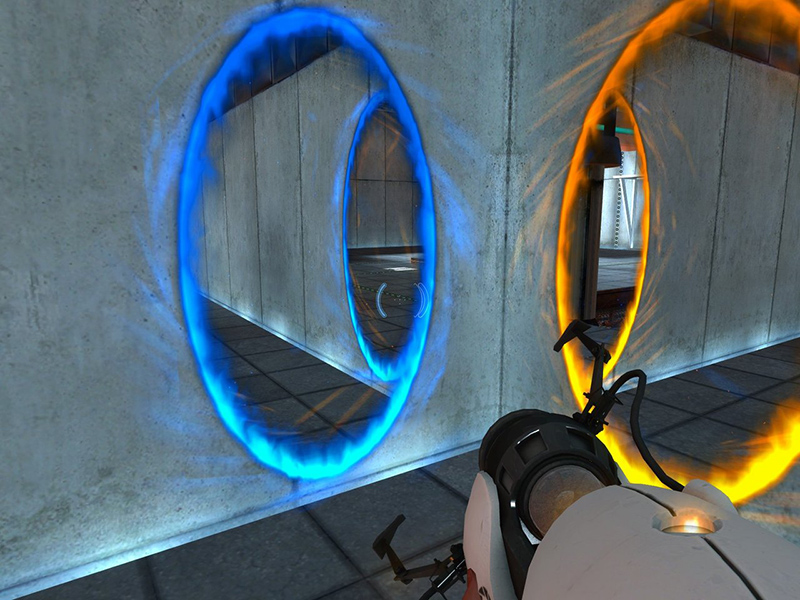 And yet, however much doubt this instills, I am still mesmerized by what I see. I look closer at the portal. What’s visible through the hole doesn’t match my intuitions of what should be there, and I feel the thrill of disjuncture. It’s seamless, this hole and its impossible interior, and so my mind accepts it. Perhaps its recursive nature – a hole that leads back out instead of in – is suggesting something more disenchanting than Portal 2’s architecture and narrative: that the backstage of the world is just the world, that it’s all there already, right on the surface. Whatever the case, the portal keeps me looking, destabilizing my vision as I try to account for this incongruous view within my view.
And yet, however much doubt this instills, I am still mesmerized by what I see. I look closer at the portal. What’s visible through the hole doesn’t match my intuitions of what should be there, and I feel the thrill of disjuncture. It’s seamless, this hole and its impossible interior, and so my mind accepts it. Perhaps its recursive nature – a hole that leads back out instead of in – is suggesting something more disenchanting than Portal 2’s architecture and narrative: that the backstage of the world is just the world, that it’s all there already, right on the surface. Whatever the case, the portal keeps me looking, destabilizing my vision as I try to account for this incongruous view within my view.
And then I see it. Instead of pushing deeper in, I follow the logic of the portal and pull further out. There’s another, more familiar kind of portal in front of me. The one I’m playing Portal on (the one you’re likely reading this essay on). The edges of my screen do not shimmer; they are set off more starkly from the bookshelf and curtain behind it. But a screen is a kind of portal, a portal a more permeable screen; I enter both, even if I parse the verb differently for each. My life is filled with screens of varying sizes, all doors, windows, holes into some other space. That space is virtual, yes, but like the in-game portals, these screens always return me, eventually, to the space I already inhabit.
 The videogame screen promises a different kind of involvement in these spaces, and Portal 2, as a game of spatial puzzles, does so explicitly. It is a videogame about videogames, part of a growing category that have taken the self-reflexive turn. I ask myself: what are GlaDOS and Wheatley testing, really? Whatever products or psychological insights might have originally been produced, the facility only tests now in order to test, a feedback loop with no escape.
The videogame screen promises a different kind of involvement in these spaces, and Portal 2, as a game of spatial puzzles, does so explicitly. It is a videogame about videogames, part of a growing category that have taken the self-reflexive turn. I ask myself: what are GlaDOS and Wheatley testing, really? Whatever products or psychological insights might have originally been produced, the facility only tests now in order to test, a feedback loop with no escape.
And yet Portal 2, the game we play, is not much different. It’s clearly been playtested all to hell, such that one needn’t fear messing up or getting stuck. The consequences may be less insidious (or maybe not, given reports about the lives of playtesters), but Portal 2 was pretty obviously inspired by game creation itself. Even Wheatley, with his stationary fixation on screens, control, and keeping the hardwired bursts of testing pleasure flowing, comes off like an obsessed gamer. When Portal players report all of the Oprah a-ha! moments that make them feel smarter, I remember Wheatley, “the dumbest moron who ever lived”, and I have to wonder.
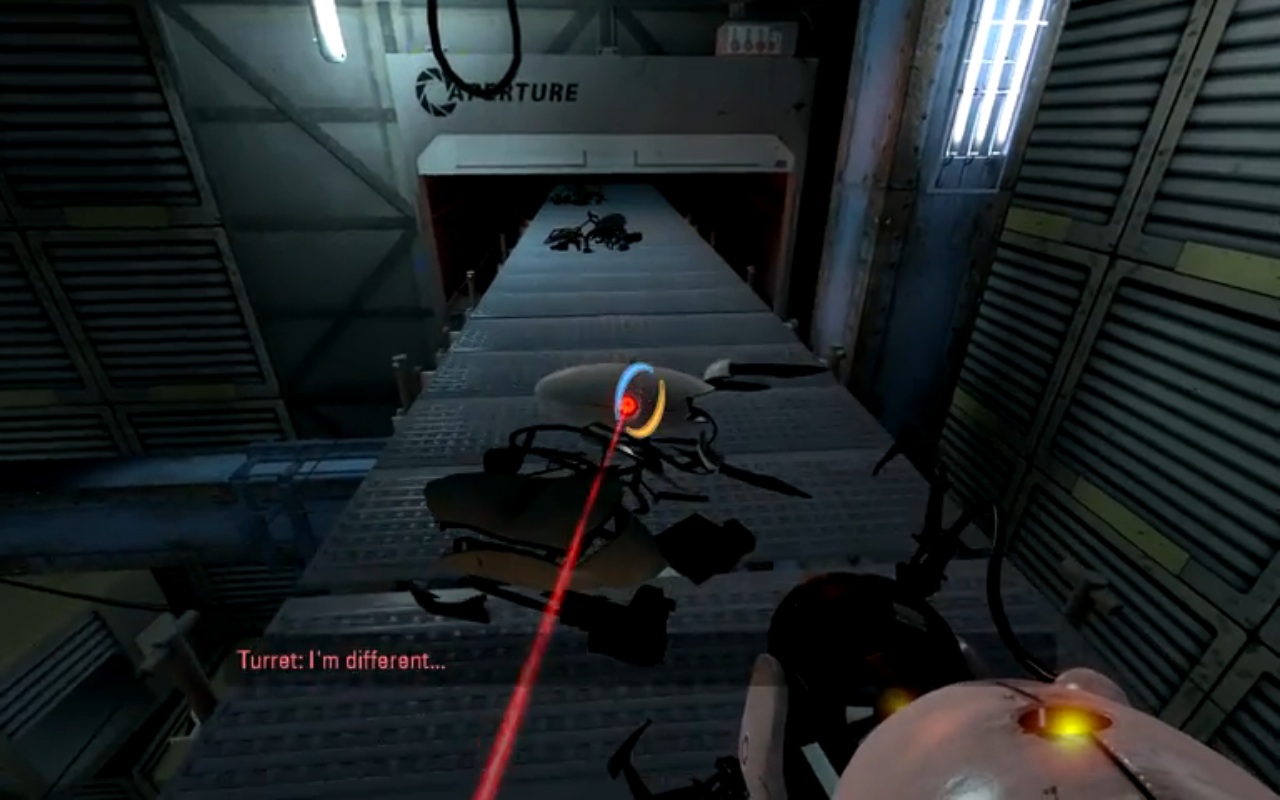 Of course, with all its sharp humor, Valve can poke fun at how we play and not completely condemn us to a similar fate, stranded in outer space. The alternative, I’ve been suggesting throughout, goes the other way – towards an inner space. I partly experience this movement in little moments of pathos: the ending aria (“my child…oh my child…stay away from Science”), the flashes of robot humanity, a certain cube, a lone turret (“I’m different”).
Of course, with all its sharp humor, Valve can poke fun at how we play and not completely condemn us to a similar fate, stranded in outer space. The alternative, I’ve been suggesting throughout, goes the other way – towards an inner space. I partly experience this movement in little moments of pathos: the ending aria (“my child…oh my child…stay away from Science”), the flashes of robot humanity, a certain cube, a lone turret (“I’m different”).
But again, these are standard narrative devices. What I want videogames to induce is not just garden-variety empathy for imaginary beings; I want them to involve me more literally. If a game wants me to see things differently, then it should actually make me SEE them differently. At its best, Portal 2 brings the perceptual force of videogames to bear on my common metaphors of vision and point of view. I fill my empty Chell and explore the consequences of the first-person in the subverted language of the FPS. This is the player, thinking with portals.
Much of this is true of the original Portal, but for all its perfection, I couldn’t quite see it, not until the sequel broadened the game’s purview. And now that I do, I am seeing portals everywhere. Screens proliferate, as do the views they provide. The more mobile ones now, the tablets and phones, serve as ever-handier portal guns, of sorts. Devices on the horizon, like the Wii U’s curious control screen, suggest a more three-dimensional immersion in the virtual. Not 3D technology that is doublescreen-based, but an augmentation of the material dimensions that surround us, a revised reality revealed by a screen window held in any direction. And so, Portal 2’s implicit interrogation of portal screens and space seems weirdly prescient.
Technology aside, Portal 2 also reminds players of the basic strangeness of space, and being a person, a point of view, within it. It may be a game of spatial puzzles, but what the portal gun points towards is space itself as a puzzle. Space, at least for the non-physics major, is as common and workaday as the air we breathe. Its co-op partner, time, may get more attention (so bound up with choice and regret), but space is just as deep. You navigate it first with your eyes, and then your body. And always with you mind, primed as it is for spatial memory.
Portal 2 plays with all of this. This is how games are changing media, minds, reality. “Without the consequence of death, is this even science?” GlaDOS asks of her robot ciphers. Without the consequence of death, this is gaming. I animate Chell as the only living human in an inhuman space, and it’s no different when I play any videogame (at least solo): the player dwells among machinery and code. If portals can compel me through the prisonhouse of such space, perhaps they can also take me up, out, to explore the surface.
It feels strangely right to spit Chell, and her cube, out into a wide-open space at the end. If we hope for any kind of escape from the confinement of bodies and murder and a limited point of view, this vision of fields and sky, of a world without portals, is comforting. And temporary. I turn off the game and, later, close my eyes. And there she is again. Shooting ahead, turning a corner. Her point of view lingers now within my own.
~ Tevis Thompson
Published June 28th, 2011

This work is licensed under a Creative Commons Attribution-NonCommercial-ShareAlike 3.0 Unported License.
